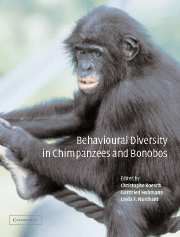Book contents
- Frontmatter
- Contents
- List of contributors
- Preface
- Behavioural Diversity in Pan
- PART I BEHAVIOURAL FLEXIBILITY
- INTRODUCTION
- 1 Multivariate and phylogenetic approaches to understanding chimpanzee and bonobo behavioral diversity
- 2 Chimpanzees in the dry habitats of Assirik, Senegal and Semliki Wildlife Reserve, Uganda
- 3 Behavioural adaptations to water scarcity in Tongo chimpanzees
- 4 Bonobos of the Lukuru Wildlife Research Project
- 5 Grooming-hand-clasp in Mahale M Group chimpanzees: implications for culture in social behaviours
- PART II SOCIAL RELATIONS
- PART III FEMALE STRATEGIES
- PART IV HUNTING AND FOOD SHARING
- PART V GENETIC DIVERSITY
- Index
3 - Behavioural adaptations to water scarcity in Tongo chimpanzees
Published online by Cambridge University Press: 08 February 2010
- Frontmatter
- Contents
- List of contributors
- Preface
- Behavioural Diversity in Pan
- PART I BEHAVIOURAL FLEXIBILITY
- INTRODUCTION
- 1 Multivariate and phylogenetic approaches to understanding chimpanzee and bonobo behavioral diversity
- 2 Chimpanzees in the dry habitats of Assirik, Senegal and Semliki Wildlife Reserve, Uganda
- 3 Behavioural adaptations to water scarcity in Tongo chimpanzees
- 4 Bonobos of the Lukuru Wildlife Research Project
- 5 Grooming-hand-clasp in Mahale M Group chimpanzees: implications for culture in social behaviours
- PART II SOCIAL RELATIONS
- PART III FEMALE STRATEGIES
- PART IV HUNTING AND FOOD SHARING
- PART V GENETIC DIVERSITY
- Index
Summary
INTRODUCTION
Chimpanzees, Pan troglodytes, occur over a wide range of habitats in Africa and their behavioural ecology is adapted to the specific conditions at each site. Numerous long-term studies of chimpanzees have been conducted across Africa, in habitats ranging from woodland forests in Tanzania (Goodall 1986; Collins & McGrew 1988), moist forests in Gabon (Tutin & Fernandez 1993), and dry open habitats in Senegal (McGrew et al. 1981; Bermejo et al. 1989) and Guinea (Sugiyama & Koman 1992). Behaviours related to the choice and collection of foods, processing of food items, and collection of water have been observed to vary from site to site. These differences have been attributed to cultural differences between chimpanzee populations and are a function both of adaptations to the ecology of the site and of learning (McGrew 1983; Boesch 1991; Whiten et al. 1999).
Similar constraints facing chimpanzees across different sites have resulted in typical, site-specific adaptations. Limited access to water in dry, open habitats such as Mt Assirik, Senegal (McGrew et al. 1981), Semliki Wildlife Reserve, Uganda (Hunt et al. 1999), and Tongo, eastern Democratic Republic of Congo, have led to the evolution of both similar and different methods for obtaining moisture. In sites where access to water can be seasonally limited, the chimpanzees have developed similar techniques for obtaining moisture, for example using tools like leaf sponges or cups.
The Tongo Chimpanzee Conservation Project of the Frankfurt Zoological Society focused on the conservation of a community of chimpanzees in the Southern Sector of the Virunga National Park, in the Democratic Republic of Congo (formerly Zaïre).
- Type
- Chapter
- Information
- Behavioural Diversity in Chimpanzees and Bonobos , pp. 52 - 60Publisher: Cambridge University PressPrint publication year: 2002
- 23
- Cited by

